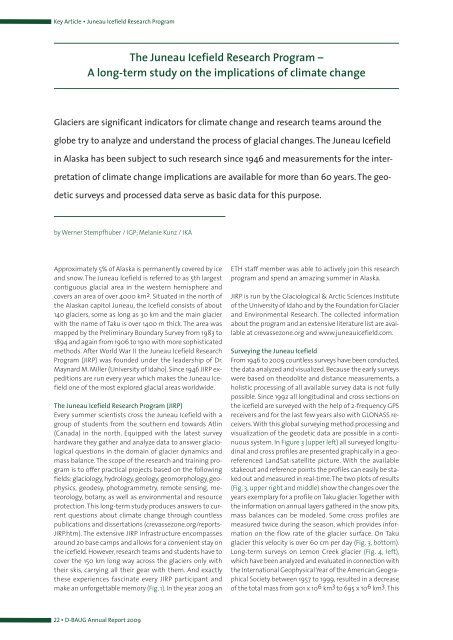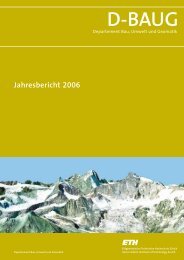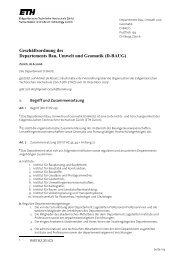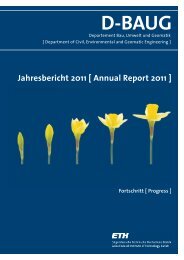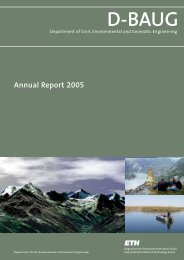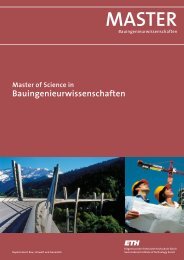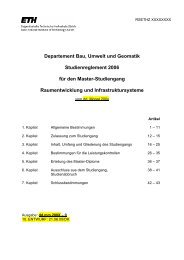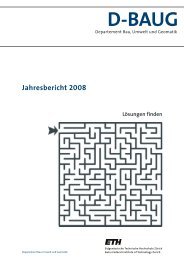D-BAUG - Departement Bau, Umwelt und Geomatik - ETH Zürich
D-BAUG - Departement Bau, Umwelt und Geomatik - ETH Zürich
D-BAUG - Departement Bau, Umwelt und Geomatik - ETH Zürich
You also want an ePaper? Increase the reach of your titles
YUMPU automatically turns print PDFs into web optimized ePapers that Google loves.
Key Article ▪ Juneau Icefield Research Program<br />
The Juneau Icefield Research Program –<br />
A long-term study on the implications of climate change<br />
Glaciers are significant indicators for climate change and research teams aro<strong>und</strong> the<br />
globe try to analyze and <strong>und</strong>erstand the process of glacial changes. The Juneau Icefield<br />
in Alaska has been subject to such research since 1946 and measurements for the inter-<br />
pretation of climate change implications are available for more than 60 years. The geo-<br />
detic surveys and processed data serve as basic data for this purpose.<br />
by Werner Stempfhuber / IGP; Melanie Kunz / IKA<br />
Approximately 5% of Alaska is permanently covered by ice<br />
and snow. The Juneau Icefield is referred to as 5th largest<br />
contiguous glacial area in the western hemisphere and<br />
covers an area of over 4000 km2. Situated in the north of<br />
the Alaskan capitol Juneau, the Icefield consists of about<br />
140 glaciers, some as long as 30 km and the main glacier<br />
with the name of Taku is over 1400 m thick. The area was<br />
mapped by the Preliminary Bo<strong>und</strong>ary Survey from 1983 to<br />
1894 and again from 1906 to 1910 with more sophisticated<br />
methods. After World War II the Juneau Icefield Research<br />
Program (JIRP) was fo<strong>und</strong>ed <strong>und</strong>er the leadership of Dr.<br />
Maynard M. Miller (University of Idaho). Since 1946 JIRP expeditions<br />
are run every year which makes the Juneau Icefield<br />
one of the most explored glacial areas worldwide.<br />
The Juneau Icefield Research Program (JIRP)<br />
Every summer scientists cross the Juneau Icefield with a<br />
group of students from the southern end towards Atlin<br />
(Canada) in the north. Equipped with the latest survey<br />
hardware they gather and analyze data to answer glaciological<br />
questions in the domain of glacier dynamics and<br />
mass balance. The scope of the research and training program<br />
is to offer practical projects based on the following<br />
fields: glaciology, hydrology, geology, geomorphology, geophysics,<br />
geodesy, photogrammetry, remote sensing, meteorology,<br />
botany, as well as environmental and resource<br />
protection.This long-term study produces answers to current<br />
questions about climate change through countless<br />
publications and dissertations (crevassezone.org/reports-<br />
JIRP.htm). The extensive JIRP infrastructure encompasses<br />
aro<strong>und</strong> 20 base camps and allows for a convenient stay on<br />
the icefield. However, research teams and students have to<br />
cover the 150 km long way across the glaciers only with<br />
their skis, carrying all their gear with them. And exactly<br />
these experiences fascinate every JIRP participant and<br />
make an unforgettable memory (Fig. 1). In the year 2009 an<br />
22 ▪ D-<strong>BAUG</strong> Annual Report 2009<br />
<strong>ETH</strong> staff member was able to actively join this research<br />
program and spend an amazing summer in Alaska.<br />
JIRP is run by the Glaciological & Arctic Sciences Institute<br />
of the University of Idaho and by the Fo<strong>und</strong>ation for Glacier<br />
and Environmental Research. The collected information<br />
about the program and an extensive literature list are available<br />
at crevassezone.org and www.juneauicefield.com.<br />
Surveying the Juneau Icefield<br />
From 1946 to 2009 countless surveys have been conducted,<br />
the data analyzed and visualized. Because the early surveys<br />
were based on theodolite and distance measurements, a<br />
holistic processing of all available survey data is not fully<br />
possible. Since 1992 all longitudinal and cross sections on<br />
the icefield are surveyed with the help of 2-frequency GPS<br />
receivers and for the last few years also with GLONASS receivers.<br />
With this global surveying method processing and<br />
visualization of the geodetic data are possible in a continuous<br />
system. In Figure 3 (upper left) all surveyed longitudinal<br />
and cross profiles are presented graphically in a georeferenced<br />
LandSat-satellite picture. With the available<br />
stakeout and reference points the profiles can easily be staked<br />
out and measured in real-time.The two plots of results<br />
(Fig. 3, upper right and middle) show the changes over the<br />
years exemplary for a profile on Taku glacier.Together with<br />
the information on annual layers gathered in the snow pits,<br />
mass balances can be modeled. Some cross profiles are<br />
measured twice during the season, which provides information<br />
on the flow rate of the glacier surface. On Taku<br />
glacier this velocity is over 60 cm per day (Fig. 3, bottom).<br />
Long-term surveys on Lemon Creek glacier (Fig. 4, left),<br />
which have been analyzed and evaluated in connection with<br />
the International Geophysical Year of the American Geographical<br />
Society between 1957 to 1999, resulted in a decrease<br />
of the total mass from 901 x 106 km 3 to 695 x 106 km 3 . This


